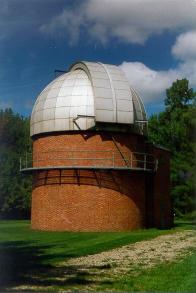 Internet-using astronomers, scientists and stargazers have planets, stars and distant galaxies in sight through the 0.9-meter telescope at Case Western Reserve University's Nassau Astronomical Station outside of Cleveland, Ohio. The telescope is America's first Earth-bound robot telescope online and accessible to the public.
Internet-using astronomers, scientists and stargazers have planets, stars and distant galaxies in sight through the 0.9-meter telescope at Case Western Reserve University's Nassau Astronomical Station outside of Cleveland, Ohio. The telescope is America's first Earth-bound robot telescope online and accessible to the public.
The software allows users to point the telescope anywhere in the observable sky. Requests are accepted for viewing times from a fraction of a second to five minutes, and for a simple image or for images through red, green and blue filters.
The robot telescope will provide two kinds of viewing. One is a deep-space image made with the telescope's main observing instrument. The other is a quick look through the big telescope's smaller finder telescope. Such quick images can be posted in real time to allow a browser to see where the telescope is pointed.
Users must provide the position of the deep-space object to be observed. That information can be found readily in online astronomy catalogues linked from the Nassau Astronomical Station web site.
Geauga Hills. Nassau Station is atop a hill in Geauga County, Ohio, 30 miles east of Cleveland. Its reflector telescope is one of three telescopes operated by Case Western Reserve University's Department of Astronomy. The robot telescope is composed of the telescope, instrumentation, camera, finder-guider, weather station, weather camera and power controls for the dome.
Each piece of equipment in the station has its own software feeding information to a master control program. A computer scheduler in the Department of Astronomy coordinates requests and sends completed images to users. When the telescope completes a round of snapshots of far-off stars and galaxies, it sends a message to the user with a link to a Web file of the images. The observatory can handle 120 pictures per night.
A robotic spectrograph will provide information on the chemical compositions of stars, how fast a star or galaxy is moving, and the temperature of an object.
Nassau's diameter of 36 inches makes it the largest telescope on the Web. There are at least two other robot telescopes, including the Bradford Robotic Telescope and University of California Santa Barbara's Remotely Operated Telescope. They are not generally available to the public.
Weather Safeguards. A camera trained on the North Star -- Polaris -- is linked to the main telescope. That's pointing toward the sky in a direction above Lake Erie, affects Northeast Ohio's weather. If the Polaris monitor sends an all-clear signal for 30 minutes, the master controller will open the dome. Weather is checked every two minutes, and the dome closes in high humidity, rain, snow, extreme cold or winds of 40 mph. Any of those conditions could damage the telescope mirrors. Snow detectors trigger electric heating elements like those used to melt snow from driveways.
The telescope is a teaching tool for sky watchers of all age, including students of middle and high school math and physics teachers participating in a Hands-On Universe science program from the Lawrence Berkeley National Laboratory.
How to Use the Telescope. Internet users can gain access to the telescope by filing a viewing request at http://astrwww.cwru.edu/nassau/nassau.html